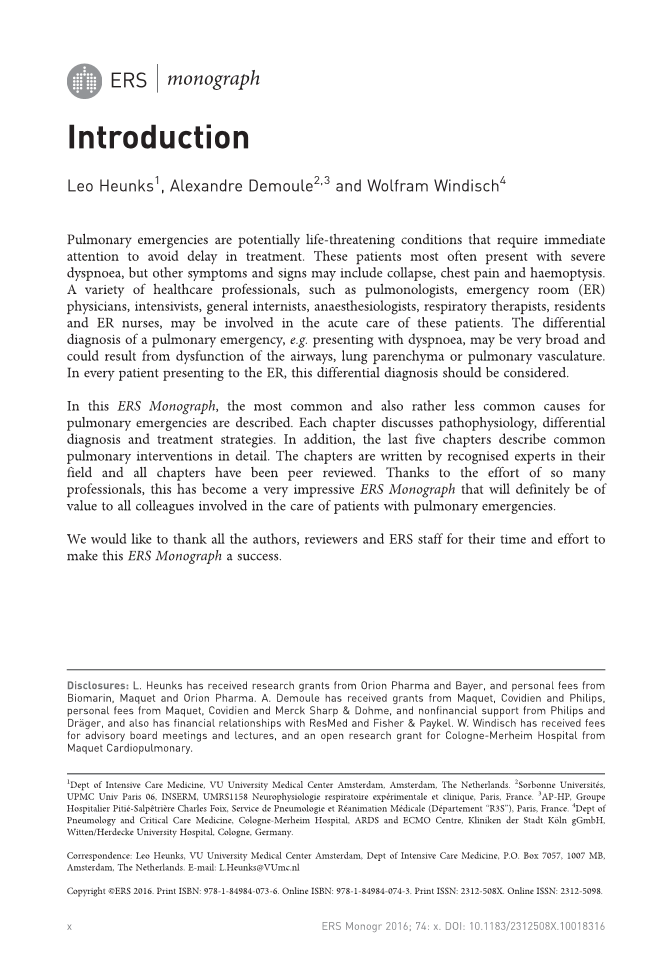ERS | monograph Introduction Leo Heunks1, Alexandre Demoule2,3 and Wolfram Windisch4 Pulmonary emergencies are potentially life-threatening conditions that require immediate attention to avoid delay in treatment. These patients most often present with severe dyspnoea, but other symptoms and signs may include collapse, chest pain and haemoptysis. A variety of healthcare professionals, such as pulmonologists, emergency room (ER) physicians, intensivists, general internists, anaesthesiologists, respiratory therapists, residents and ER nurses, may be involved in the acute care of these patients. The differential diagnosis of a pulmonary emergency, e.g. presenting with dyspnoea, may be very broad and could result from dysfunction of the airways, lung parenchyma or pulmonary vasculature. In every patient presenting to the ER, this differential diagnosis should be considered. In this ERS Monograph, the most common and also rather less common causes for pulmonary emergencies are described. Each chapter discusses pathophysiology, differential diagnosis and treatment strategies. In addition, the last five chapters describe common pulmonary interventions in detail. The chapters are written by recognised experts in their field and all chapters have been peer reviewed. Thanks to the effort of so many professionals, this has become a very impressive ERS Monograph that will definitely be of value to all colleagues involved in the care of patients with pulmonary emergencies. We would like to thank all the authors, reviewers and ERS staff for their time and effort to make this ERS Monograph a success. Disclosures: L. Heunks has received research grants from Orion Pharma and Bayer, and personal fees from Biomarin, Maquet and Orion Pharma. A. Demoule has received grants from Maquet, Covidien and Philips, personal fees from Maquet, Covidien and Merck Sharp & Dohme, and nonfinancial support from Philips and Dräger, and also has financial relationships with ResMed and Fisher & Paykel. W. Windisch has received fees for advisory board meetings and lectures, and an open research grant for Cologne-Merheim Hospital from Maquet Cardiopulmonary. Copyright ©ERS 2016. Print ISBN: 978-1-84984-073-6. Online ISBN: 978-1-84984-074-3. Print ISSN: 2312-508X. Online ISSN: 2312-5098. Correspondence: Leo Heunks, VU University Medical Center Amsterdam, Dept of Intensive Care Medicine, P.O. Box 7057, 1007 MB, Amsterdam, The Netherlands. E-mail: L.Heunks@VUmc.nl 1 Dept of Intensive Care Medicine, VU University Medical Center Amsterdam, Amsterdam, The Netherlands. 2 Sorbonne Universités, UPMC Univ Paris 06, INSERM, UMRS1158 Neurophysiologie respiratoire expérimentale et clinique, Paris, France. 3 AP-HP, Groupe Hospitalier Pitié-Salpêtrière Charles Foix, Service de Pneumologie et Réanimation Médicale (Département “R3S”), Paris, France. 4 Dept of Pneumology and Critical Care Medicine, Cologne-Merheim Hospital, ARDS and ECMO Centre, Kliniken der Stadt Köln gGmbH, Witten/Herdecke University Hospital, Cologne, Germany. x ERS Monogr 2016 74: x. DOI: 10.1183/2312508X.10018316
